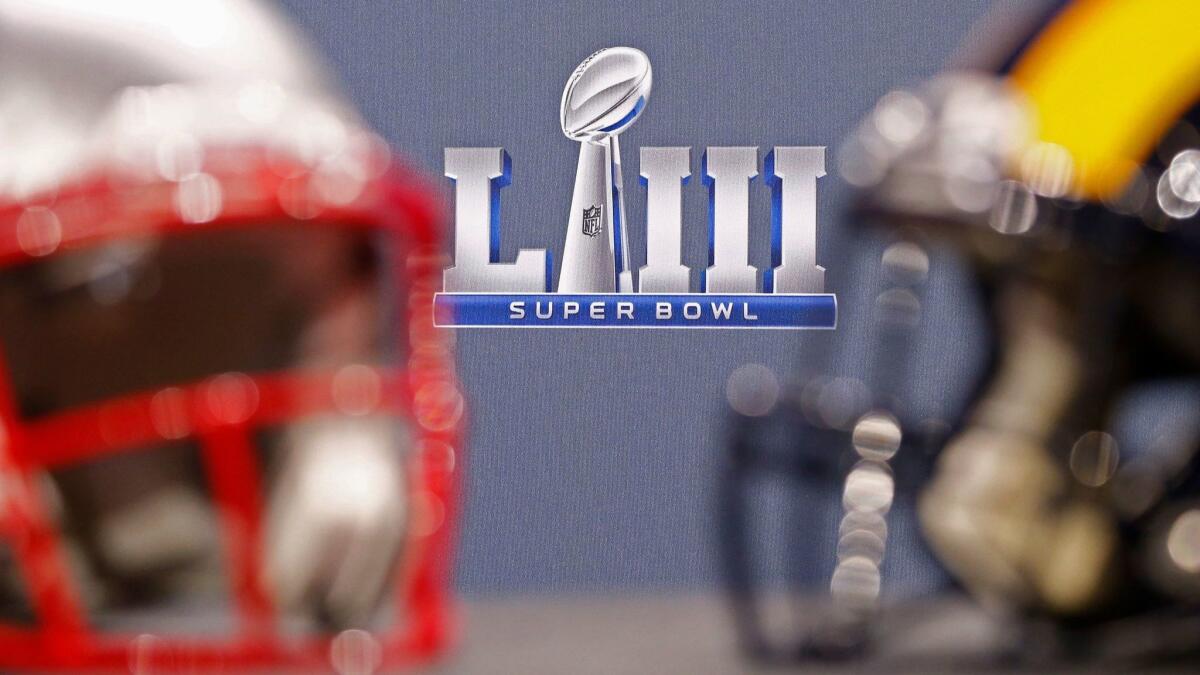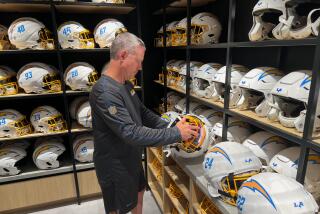Op-Ed: High-tech helmets won’t solve the NFL’s concussion problem

- Share via
It’s long been clear that football has a brutal concussion problem. And if you’ve been following the breathless headlines about the new generation of high-tech helmets now on the market, you might think these expensive, tricked-out helmets are the solution.
They’re not.
Some research has concluded that a well-designed and properly fitted helmet can reduce the risk of concussion, but no helmet, unless one is invented that can be inserted directly into the skull, can prevent concussion. More padding and new materials might soften the blows, but nothing on the outside of a player’s head can stop a brain from sloshing around and slamming against the skull after a violent hit or bounce on hard turf.
Take the VICIS Zero1, the “multilayered, highly engineered” new helmet now being lauded as the safest in NFL tests. It has fancy polymers and a deformable shell that’s said to absorb shock like a car bumper. It sells for $950. But even a helmet with all that technology didn’t prevent Houston Texans linebacker Brian Cushing from getting a concussion in his opening game last season.
No helmet, unless one is invented that can be inserted directly into the skull, can prevent concussion.
There’s also the important question of how much you can trust helmet safety ratings. Two scientists who analyzed commonly used helmet safety ratings found they were basically meaningless, with no correlation between the ratings and how well they protected athletes. So the duo, Stefan Duma and Steven Rowson, started a safety testing lab at Virginia Tech independent of funding or influence from helmet manufacturers.
Their ratings make clear that getting the best protection a helmet can offer doesn’t have to break the bank. While the Zero1 and a $1,700 Riddell helmet built using 3-D scans of players heads definitely performed among the best in the tests by Duma and Rowson, so did seven other helmets that cost less than $300.
Even the best helmet can’t offer protection unless a player wears it, and one big problem with the new helmets has been convincing players to put them on. Many of the safer helmets are bigger, bulkier and heavier than old-school helmets, and many players have rejected them. L.A.’s Public Enemy No. 1, New England Patriots quarterback Tom Brady, is among numerous players wearing a helmet that provides so little concussion prevention that it’s on a list of helmets banned for next season.
The false sense of security engendered by the new helmets is also a problem. If players and coaches buy into science jargon, heavy marketing and statistical games that suggest new helmets are better at cushioning heads and protecting brains, players could be more willing to continue to use those heads as weapons during tackles.
Enter the Fray: First takes on the news of the minute »
Yes, it would be wonderful if technology could solve football’s concussion crisis, and there should be more and better research into how to prevent concussion and chronic traumatic encephalopathy with technology. Scientists should continue to develop the best helmets possible and better insulation to soften turf fields. But in the case of protecting players, we don’t need more science. We need more common sense. The NFL, its coaches and medical teams must act more urgently to immediately remove any player suspected of having a concussion. Players, who worry so much about their contracts and spots on rosters, need to leave games when medically necessary to protect their short- and long-term health.
There have been some improvements in recent years. The NFL is adding more “unaffiliated neurotrauma consultants” who aren’t as beholden to teams to help make medical decisions on the field. This season, despite the outcry of many fans, the league prohibited the lowering of helmets to initiate contact in an effort to protect brains. But the league needs to take more action, including putting a stop to “Thursday Night Football” games, which have the highest injury rates because players have had less recovery time.
More than 100 million people will watch this year’s Super Bowl. If you’re going to be one of them, and you care about the players on the team you’re rooting for, then don’t fall for the fantasy notion that fancy new helmets are going to protect their brains. Instead, support changes to the game that will truly protect players.
Usha Lee McFarling, a former science writer at the Los Angeles Times, won a Pulitzer Prize for explanatory journalism in 2007.
More to Read
A cure for the common opinion
Get thought-provoking perspectives with our weekly newsletter.
You may occasionally receive promotional content from the Los Angeles Times.










